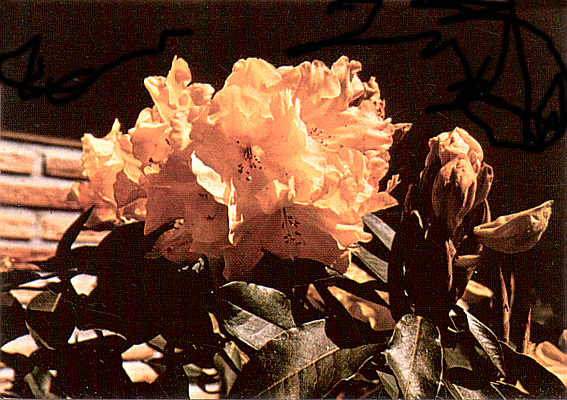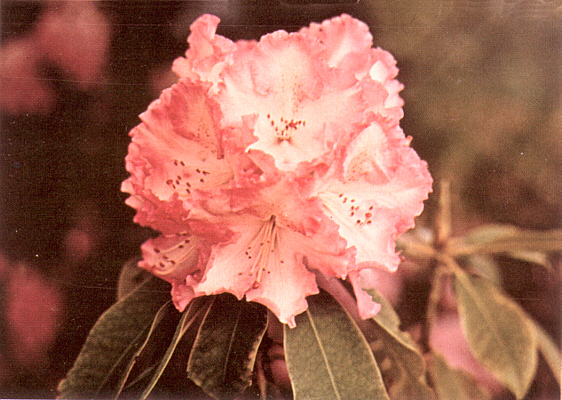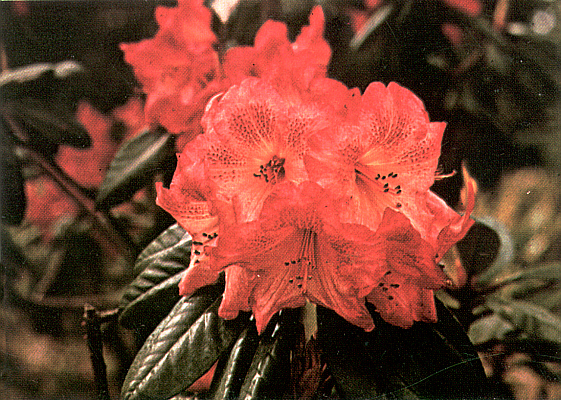QBARS - v30n4 The Whitney Gardens Story
The Whitney Gardens Story
by George M. Sather, Brinnon, Washington
|
||
|
The lines of a popular song come to mind each time I think of the late William E. Whitney and the Gardens he founded at Brinnon, Washington in 1955. The lines are "Imagination is funny, it makes a cloudy day sunny."
Anyone, who has been privileged to visit the Gardens in the spring, will certainly have their imagination challenged. Over the years Mr. Whitney produced hundred of hybrids. He awaited each spring with eager anticipation and excitement. He savored the new blooms and plants. He loved each and every one. But there was always next year. Thus for 15 years here, as he had for over twenty years elsewhere, he worked with his beloved rhododendrons. His knowledge of the genus seemed boundless.
Because of his dedication to these lovely plants, a steady procession of rhododendron enthusiasts visited, and in some cases would present him with a cutting or plant in exchange for a favor. ''Bill'", as his friends called him, was a modest man who avoided publicity. If he decided not to sell a plant or group of plants to someone, they would not be sold. On the other hand he might just decide to give the same plant away to someone else. He enjoyed talking rhododendrons with almost anyone. In fact, this was, I think, what he loved the most.
I recall shortly after my wife Anne and 1 moved to the Gardens, we were walking around the place with Bill. About the middle of the west line he stopped and gestured towards an extremely crowded group of plants and said, "There are some pretty good pinks of mine in that group". It did take a bit of doing to sort them out. After having done so, two of them were named, "Pleasant Dream" and "Blind Date". But I think I should start at the beginning of this story.
As far as we were concerned, it started on a lovely Sunday afternoon in February 1968. At the urging of our neighbor, we had driven to Brinnon for a look. We needed some plants as we were adding to our landscaping. Well, one visit lead to others as the blooming season progressed. The utter fascination was simply overpowering. This fascination carried over to the next year and when 1970 rolled around, we had decided to grow rhododendrons as a hobby when I retired, about two and a half years hence. Our suggestion to Bill was, that we could help him during the busy season in exchange for his sharing his knowledge of growing and hybridizing rhododendrons with us. He readily accepted.
Brinnon is located on the west shore of Hood Canal, on the Olympic peninsula in the State of Washington. It is over 50 miles from Seattle, Washington via toll bridge and ferry, and 40 miles from any major city. Due to the location, weekends were the time for visitors and for those wishing to purchase rhododendrons to come. It could, at times, get very crowded and extremely busy. It was on just such a Sunday evening that Bill, Anne and I were sitting around and relaxing a bit before we left for home. Stan Donnelly, Bill's gardener had just gone home. Faye, Bill's wife was tidying up the home after serving coffee and goodies to countless numbers of people. Mr. Whitney dropped a suggestion that was sort of a bomb. "Why don't you folks buy this place?" There was a moment of silence, Anne finally said, "You must be kidding". My thoughts on the suggestion were indescribable. I knew there were species and hybrids. Bill had told me of lepidotes and elepidotes, there my knowledge ended. I had never even tried to root a cutting. I finally managed to say, "I think it would be foolish for us to get so involved. We shall return next week to help if you need us."
We headed north on Highway 101. It was a beautiful warm evening, the native R. macrophyllum was just beginning to bloom, the Pacific Dogwoods were still to be seen. I think there is no area that is more spectacular in the spring than the drive along the Hood Canal west shore through Brinnon and on to Quilcene.
During the week there was some discussion of Bill's proposal. The question seemed to be, not whether we should buy the place, but how best to handle it if we did. We had seen rather intimately the thousands of rhododendrons on the place. We noted also, that such display was not common, in fact, here were varieties to be seen nowhere else. We came to the realization that to work with a place such as this was a privilege, that few people ever have this kind of an opportunity to sort out the best new varieties. The next weekend we told Mr. Whitney of our decision. He seemed not the least surprised.
We moved to the Nursery in late August 1970. We were suddenly visited by collectors, looking for the rumored 'Kilimanjaro', R. recurvoides or R. proteoides . Eventually we did find all of these and more. There were plants everywhere. In the greenhouses they were in the bins, under the bins and on racks above the bins. The lathe houses were so closely planted they were supporting each other. One could not walk anywhere without keeping a sharp eye for a little thing hidden under or behind.
It does seem rather comical now, when I recall that at first we tried to save everything. After a few months, we abandoned that idea. But we did need ground in which to grow young plants. The idea of actually destroying a rhododendron was abhorrent, but what do you do with plants 10 feet tall, planted about a foot apart? We finally came up with a sort of solution. We would take cuttings of most of the things we destroyed. We had one bin in which we put these cuttings, 1200 or more and we could not identify a single one. It got to be a rather hilarious situation when someone would ask, what's this or that? We are just now seeing some of the plants bloom, and in my judgment it was all worth while.
In fact, the problem of identification is still a major one with some of these. Besides several good yellow-flowered varieties, we have seen some we call our oddballs, because they are different. The name Bridal Bouquet was given to one of these plants by a lady who wished to purchase it. She was very disappointed when we refused to part with the one and only.
One disadvantage to a place such as this is that we are kept so busy here we do not get to many of the shows and other events we would like to attend. I liken our sojourn here to a ride down a swift river, you can't get off, you must keep going and all the while you are enjoying every moment. What is around the next bend may be something even more beautiful and exciting. At this writing, 1976 was all that we thought it would be, even more.

|
|
R. 'Morning Sunshine'
Photo by George Sather |
The decision of which rhododendrons to name proved to be very difficult in some cases. In the case of 'Morning Sunshine', there was no problem. It was so outstanding in every way, it would have been an injustice to overlook this lovely plant. 'Morning Sunshine' will be registered shortly. If we only knew the parentage. If I may digress for a moment, the old be ignorant of the past is to constantly start over. We do include parentage if we know it. We do not speculate on what we think it may be.
In the case of naming, we were influenced largely by our customers and visitors and, of course, by the difficulty of propagation. In the case of the latter, it often requires several years to learn which method works. At any rate we do hope we made the best possible decisions. There were many Whitney hybrids in the trade for a number of years. 'Virginia Richards', 'Honeymoon', 'Hurricane', 'Ruby Hart' and 'Whitney's Orange', to name a few. These, of course, must be registered. In any case the color and description was done by Anne with the help of some kind friends. Were it not for her, most of this would not have been possible.
One of the last times I visited with Mr. Whitney I asked him for his opinion as to the direction future hybridizers should take. He said, "First improved foliage and plant habit, flower substance and plants that will do well in sun and stand more heat and cold. We need some good reds, true color, hardy. I would like to see rhododendrons the color of 'Orangeade' azalea and the color of 'Gibraltar' azalea. We need to work on foliage color. There are real possibilities in the double flowered varieties. The most important thing is for a hybridizer to start young. There is a saying, "we get so soon old and so late smart"."
The rhododendron world owes much to Bill and Faye Whitney for the work they did here. If we have helped to perpetuate what they started here, we have been successful in what we set out to do.
Perhaps the most significant day of our lives at the Whitney Gardens, occurred the day that Bill came, at our request, to see an outstanding new yellow that had been blooming a few days in late April 1973. As we walked towards the plant, I noticed he had a small vial in one hand. We stopped about 15 feet away from the blooming beauty and stood in silence for a moment. Bill slowly put the vial in his. pocket and walked to the plant, we followed. I said, "Anne thought the name 'Morning Sunshine', would be appropriate." I do not know the words to describe this moment. Bill cupped his hands around that lovely truss and said, "Beautiful, beautiful, I brought pollen from macabeanum to improve the yellow color, but 'Morning Sunshine' needs no improvement." "Imagination is funny it makes a cloudy day sunny."


